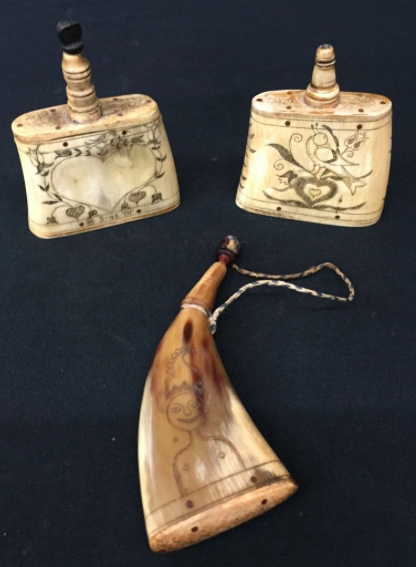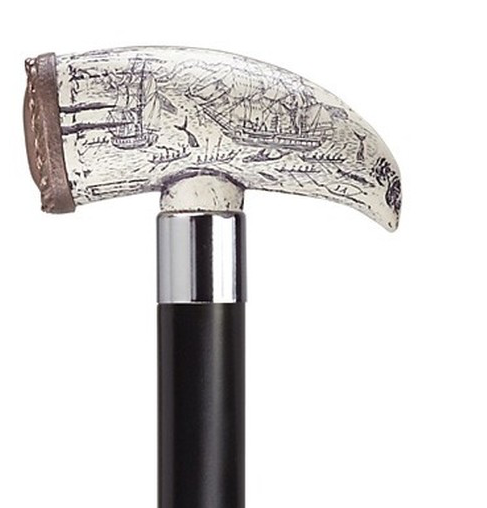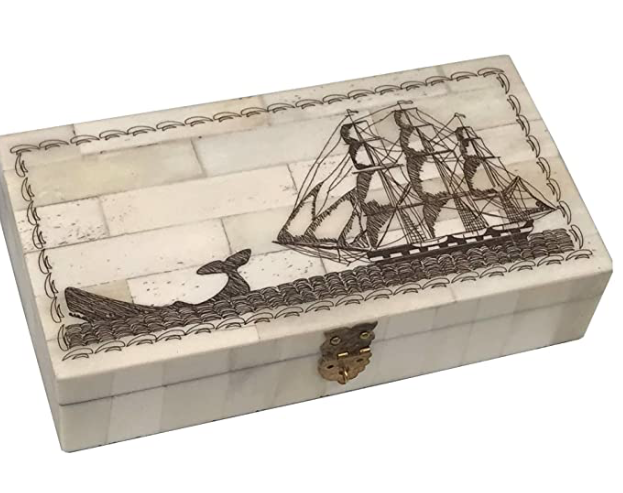Scrimshaw and it's 'Predecessors'
- Renée Whitehouse

- Apr 6, 2020
- 11 min read
Updated: Mar 30, 2024
The practice of scrimshaw is an art form that harkens back thousands of years, as a seemingly disconnected extension of bone carving. If the name 'Scrimshaw' doesn't sound familiar, not to worry, you'll recognize it when you see it. The newer instances weren't built off of, or following from the original practice, but I think it shows a human desire to bring something ordinary and make it extraordinary.
(These are just a few examples of a very common hobby. For more.)
The European Kickoff
Scrimshaw is the practice of, and the objects created that have, scrollwork, carvings, and/or engravings, historically on bone or ivory. The most commonly use material was whale teeth (whale ivory) and baleen since the material was easy to come across by the whalers in the late 1700s through the early 1900s (Shoemaker, 2019: 17). Sailors would use knives or, more commonly, ship needles to create the designs (Brooklyn Museum, 1909: 67). As this activity was typically tied to the sailors and whalers from multiple European countries and the colonies and countries to follow they mostly portray images relating to the maritime lifestyle and culture.
Hunting for whales' 'usable products' like their meat, ambergris, spermaceti, and the creation of whale oil from blubber during the Industrial Revolution was the jolt that made the whale industry (Shoemaker, 2019: 17). But, sperm whales weren't the only animals used in this hobby. Other species of whale, seal, and dolphins bones, narwhal, walrus, and elephant tusks, various skulls and horns, and hippo teeth were also used. Animals such as the walrus were commonly from the whalers who traded with various groups of indigenous peoples. Realistically, people used whatever they could be their hands on, including tropcial nuts and wood (West, 1991: 39). There are also records of a brief time of trading going on with the people in Micronesian and Polynesian cultures. In Fiji, for example, Europeans cut down wood so they could sell it in China, and traded them the whale teeth, as it seemed to have already possessed deeply symbolic high-status as "objects exchanged and displayed as symbols of divinity, truth, integrity, trust, wealth, and power" (Shoemaker, 2019: 19). Because this was, presumably, a reciprocal gift giving tradition that already existed, this implies to me that the people of Fiji already hunted whales or dolphins or sharks and used the larger bones to make tools and/or art.
Though the true origins in the European context are disputed, the first example of scrimshaw as leisure activity is thought to be a whale tooth dated to, at least, 1817 (Shoemaker, 2019: 20). The engraving included an image of the London whale-ship Adam and a text relating that it was docked in the Galapagos Islands (Shoemaker, 2019: 20). An earlier piece, which has been dated to a South Sea sealing expedition in 1766, was carved out of whale bone into a busk (Dyer, 2018: 841-5 & West, 1985: 702-4). So as one of the earliest examples shows, these art pieces weren't only carved for teeth shaped decor, they would also be shaped in cane toppers, corset busks, yarn winders, pie crimpers, jewelry box and knife inlays, etc (Shoemaker, 2019: 20). If that tooth in 1817 was the first widely known instance, the sailors who followed chose an interesting hobby to copy that couldn't continue for very long, as it really wasn't sustainable.
The photos above are various examples of different shapes that scrimshaw took and the multiple types of materials used. These include the sperm whale teeth, an ostrich egg, a walrus rib, and Chinese Ox Bone. Not in precisely that order, with the links in order at the end of the post.

These scrimshaw human skulls are dated to 1901 [left] and 1868 [right]. While they may look real, and the carvings are beautiful I couldn't find any factual evidence to show that they were legitimate (So beware of counterfeits if you want to buy scrimshaw, but also be aware as it is looked down upon nowadays and is often illegal*.)
Earlier Instances of Bone Work
As I showed in a few of the pictures above, scrimshaw was not a throughly European or Western art form (just look at the Chinese ox bones). Archaeologists can now use types of spectroscopy, such as SERS (Surface Enhanced Raman Scattering) to examine the materials (at a molecular level) that had been used on a carving, painting, etc. ("SERS Unlocks Secrets Of Ancient Artifacts"). I don't have much ability to explain this other than light passing through atoms and molecules and giving them a specific color, which identifies them as what they are, so I'll leave it to you if anyone wants to learn more as this study is very new when it comes to looking at archaeological contexts.
The earlier models of bone carving served a different purpose. Not only did people in Indigenous groups, including [but the Inuit, Sami, Māori & other Indigenous from around the world practice subsistence [providing for basic needs], but the artistic carving3 was also an extension of carving tools like the European tradition, but in reverse. All over the Paleolithic to the modern world, bone tools such as arrow and spear points, awls, needles, hooks, musical instruments, etc. were fashioned out of the bones of hunted animals (Buk, 2007 & Handwerk, 2011). The Neanderthal to the Homo sapiens, a belt hook to a flute, many things were made out of bone, especially because bone was easier to work than stone.
1st: A bone object found in the Bronze Age layers of Yanik Tepe located to the northeast of Lake Urmia, some 20 km from Tabriz, Iran.
2nd: Fragment of a Kylix, Greek, 510-500 BCE, Terracotta, red-figure technique
3rd: The Bone Player by William Sidney Mount in 1856
4th: Dated to between 800-1200 CE"Bone whistles are the most ancient musical instruments known. Six bone whistles have been found from archaeological excavations in Exeter, all but one from Norman rubbish pits" (BBC)
5th: Flutes, made from bird bone 42 to 43 thousand years ago in Southern Germany out of mammoth ivory (BBC, 2012). [Full scientific article].
6th: 8000-9000 year old Chinese flutes made from bird bone.
Other than making carvings of animals in bone and creating music some of the earliest civilizations used the engraving of bone as tally sticks [tools used to record numbers] as far back example of the tally stick itself as possibly between 44,200 and 43,000 years old (Flegg, 2002: 41–42 & "A Brief History...", 2008). Wood was also used for this purpose [just like in scrimshaw], as explained by the Roman scholar Pliny the Elder (23-79 BC) [the tally part, not the scrimshaw part]. Looking at the oldest example of bones being used for a possible tally was the Ishango bone, made out of a baboon fibula ("A Brief History...", 2008 & Pletser, 2012). Whether or not the marks were carved for tally markers or, as other scientists suggest, make the tool easier to grip, it does display earlier human carving for a purpose. To create something, not just a remnant of a hacking of meat. One of the most abstract ideas of art would be a musical instrument, and that's just so human, experimenting until something goes right.
The Polynesian Fish Hook: Māori-Hei Matua
For one of my favorite examples of beautiful bone work we can turn to is Maui's giant fishhook, called Hei Matau in the Māori and Manaiakalani in Hawai'ian; two examples of the hook's 'name' in native languages. Maui's Fish Hook lives on in many myths, for this blog I'll focus on one of ways he got it in the first place. [I just want to say that this will be based off of online articles, unfortunately not oral tradition, but also not Disney; so it's not 'eh...', but not nearly as accurate as it should be, but a lot of tales are contradictory, and I'm sorry for not covering all of them.]
The youngest of eight sons, Maui was left as an infant, wrapped in either hair or seaweed, in the sea alone. Lucky for Maui, his extended family (his divine ancestor Tama-nui-te-rā or Rangi) was looking out for him and raised him as more than a human (McLintock, ed.,1966). In one of his earlier adventures, Maui fashioned his special giant fishhook carved from, either the jawbone of his grandmother, Muriranga-whenua/Mahuika the goddess of fire, or a jawbone she gave him and then used it to craft a club and his special fish hook to tame the sun and then on a special fish trip that he takes with his older brothers, which ends up fishing up the islands (Higgins and Meredith, 2011 & Grace, 2016). Whatever incredible way Maui obtains his fish hook he uses it in the origin story, the fishing trip, for multiple island chains, including Hawai'i and New Zealand. Being the ones I've read most about, mainly from where I've lived and what I've read and heard most about so far those are the traditions I know more about. Even with basic searches, there are versions for almost every island chain and it's AWESOME and very confusing.

The three circular fish hooks (which make it more difficult for fish to swallow) and one j-hook (Prince, 2002) are examples of the artistic and real life importance of the art of carving difficult materials, bone or otherwise. At least two of these pieces were not meant to be used as hooks. I'll give you a hint, it's the 1st and 3rd.
1) Aged Bone: https://www.earthboundkiwi.com/products/antiqued-maori-hawaiian-fish-hook-scrimshaw-necklace/
2) Object: Matau (fish hook)Museum of New Zealand Te Papa Tongarewa. Retrieved 8 September 2016
4) Wooden and Paua shell Matau (dated to between 1800-1900): https://en.wikipedia.org/wiki/Hei_matau#/media/File:MAP_Expo_Maori_Hameçon_13012012_04.jpg
Above are more examples of actual fish hooks from Polynesia and the latter three from North America. The third one is a Halibut fish hook from Alaska: http://www.lithiccastinglab.com/gallery-pages/2009aprilfishhookspage1.htm.
Fish hooks from all over the Pacific, and the world were typically carved out of bone, wood, shell, pounamu, or a sort of combination of any of these. [Except for pounamu (green stone/nephrite), as it seems to be mostly found in New Zealand. While paua are also used commonly for necklace decoration nowadays, bone, and more commonly poumanu, were used as gifts. Like I mentioned in my own thesis, as related from other scholars, pounamu, was deeply tied to the mythology of the islands and was utilized more often for religious pieces and jewelry than for tools (Paulin, 2009).
In any case, we can see that the bones from various animals were being utilized in the hunting for more food. But, we can also see, in the first example I introduced, that the Māori [one example] had enough material to create necklaces (examples of artwork) out of the idea of tools/mythology. This shows, almost irrevocably, that once cultures have enough of the materials that go towards creating the tools that are needed some the surplus is used creatively for art works.
Modern Scrimshaw
Of course, in our modern day situation, we are definitely not in need of materials nor any art pieces we can personally afford. The lack of material is not what we worry about at this point. If one is wanting to buy scrimshaw people should be aware of fake ones, as they are prevalent since replications are mostly made of alternative materials now. This is because in many countries the trading or selling of the ivory and other bones is illegal without a permit because of the bans on whale and general ivory hunting.
[*it's illegal because of poaching laws, duh.]
It wasn't long before whales, especially with the advance in the whaling industry, were becoming critically endangered, which was one of the initial victims of the Marine Mammal Protection Act of the year 1972. This was still desperately needed after the international regulation on whaling starting in 1931 and culminating in the International Convention for the Regulation of Whaling (ICRW) in 1946. It wasn't only whales, dolphins, seal, and walruses; with the poaching of elephants and other land mammals and birds the next year the Endangered Species Act showed up in 1973. So, luckily, now it is illegal to hunt these species [though this doesn't stop everyone], but antiques and other random pieces are still commonly being circulated over the internet. (Some that I found while researching, presumably.)

There are ongoing arguments about whether scrimshaw is ok, especially new pieces, but with other practices of subsistence in Indigenous groups my personal opinion is yes. People should use all they can from an animal; waste not, want not and that includes souvenirs for money to buy more necessary items (modern economy, sigh). There are countries and groups that still hunt whales and seals, and they should be able to prosper with all they have. It's complex, but as long as one can be sure of who and where it came from, so random people aren't abusing the perceived lax of regulations, be fair.
If appropriate, therefore, I would like to advise potential buyers (which I wouldn't blame anyone for per se) to buy replicas, at least that way we will be telling anyone looking at getting into the business that people aren't interested in dead animals from just anyone. One can only hope that that could make a difference.
All over the world people carved anything and everything we could use. Art tends to come after the most basic human needs are met. We don't have to get too philosophical, and it's not to say people who are hungry don't or can't art, just that it generally comes after because there is less to worry about (citations). If we found that to be completely true, much of the earliest art that archaeology finds would not exist. That also means that art comes out of the ordinary, the everyday, as we can relate to the transition of tools to art pieces (or even both). Stories, mythology, art, they all have reasons for existing.
To learn a possible beginning to the word SCRIMSHAW
IMAGES:
(that weren't discussed earlier):
Fishhooks
Gallery:
(dates are from what the site says - take them with a grain of salt)
Jewelry (1800s): https://poshmark.com/listing/Scrimshaw-antique-pin-and-earrings-5be8bfd5f63eea90caeb9bfe
Ostrich Egg (mid-1800s): https://www.worthpoint.com/worthopedia/antique-5-scrimshaw-ostrich-egg-52042170
Powder Horn (1878): https://deyoung.hibid.com/lot/83091-127077-11464/powder-horn--scrimshaw--antique/
Collection of Flasks and Horn (1902): https://www.icollector.com/Antique-Scrimshaw-Ivory-3-Items_i24736914
Walrus Rib (1860-1910): https://www.lot-art.com/auction-lots/Antique-Walrus-Rib-Scrimshaw-1860-1910-Obodenus-rosmarus-1x5x40-cm/32523801-antique_walru-04.1.20-catawiki
Ox Bone Reproduction Box: https://www.amazon.com/Schooner-Bay-Co-Scrimshaw-Reproduction/dp/B07JLTDPDN
CITATIONS:
A very brief history of pure mathematics: The Ishango Bone. (21 July 2008) Wayback Machine. University of Western Australia School of Mathematics.
Buc, Natacha; Loponte, Daniel (2007)."Bone tool types and microwear patterns: Some examples from the Pampa region, South America".Methods and Interpretations in Worked Bone. inapl.gov.ar. pp. 143–157.
Dyer, Michael P. "Scrimshaw."Encyclopedia of Marine Mammals. Academic Press, 2018. 841-845.
Flegg, Grahams. Numbers: their history and meaning, Courier Dover Publications, 2002. ISBN978-0-486-42165-0, pp. 41–42.
Grace, Wiremu (2016)."Māui and the giant fish".Te Kete Ipurangi. Te Tāhuhu o te Mātauranga. Retrieved 19 January 2019.
Handwerk, Brian (2011)."Bone Deep".National Geographic Daily News.
McLintock, Alex, ed. (1966), Encyclopaedia of New Zealand, Government Printer.
Paulin, Chris (2009)."Porotaka hei matau - a traditional Maori tool?".Tuhinga: Records of the Museum of New Zealand Te Papa Tongarewa. 20: 15–21.
Pletser, Vladimir (2012). "Does the Ishango Bone Indicate Knowledge of the Base 12? An Interpretation of a Prehistoric Discovery, the First Mathematical Tool of Humankind".
Prince ED, Ortiz M and Venizelos A (2002)"A comparison of circle hook and" J" hook performance in recreational catch-and-release fisheries for billfish" 2012-02-17 at the Wayback Machine. American Fisheries Society Symposium 30: 66–79.
Higgins, Rawinia and Meredith, Paul. (2011). 'Kaumātua – Māori elders - Kaumātua in early traditions', Te Ara - the Encyclopedia of New Zealand. http://www.TeAra.govt.nz/en/artwork/28358/muriranga-whenua.
"Scrimshaw Collection at the Scott Polar Research Institute". University of Cambridge. Retrieved 2015-08-26.
“Scrimshaw Work”. The Museum News (Brooklyn Institute of Arts and Sciences), vol. 4, no. 5, 1909, pp. 66–68.JSTOR, www.jstor.org/stable/26460937.
"SERS Unlocks Secrets Of Ancient Artifacts".Fosterfreeman.Com, 2020, http://www.fosterfreeman.com/forensic-industry-news/128-sers-unlocks-secrets-of-ancient-artifacts.html.
Shoemaker, Nancy. “Oil, Spermaceti, Ambergris, and Teeth: Products of the Nineteenth-Century Pacific Sperm-Whaling Industry.”RCC Perspectives, no. 5, 2019, pp. 17–22.JSTOR, www.jstor.org/stable/26850617.
West, Janet. “SCRIMSHAW AND THE IDENTIFICATION OF SEA MAMMAL PRODUCTS.”Journal of Museum Ethnography, no. 2, 1991, pp. 39–79.JSTOR, www.jstor.org/stable/40795035.
West, Janet. "Elephant seal scrimshaw and sealing on the ‘Islands of Desolation’."Polar Record 22.141 (1985): 701-706.
FUTHER READING:
Chase, Phillip G., and Harold L. Dibble. “Scientific Archaeology and the Origins of Symbolism: a Reply to Bednarik.”Cambridge Archaeological Journal, vol. 2, no. 1, 1992, pp. 43–51., doi:10.1017/S0959774300000469.
Frank, Stuart M. Ingenious Contrivances, Curiously Carved: Scrimshaw in the New Bedford Whaling Museum. Boston: David R. Godine, 2012.
Pozzi, Federica, and Marco Leona. "Surface‐enhanced Raman spectroscopy in art and archaeology."Journal of Raman Spectroscopy47.1 (2016): 67-77.
Thomas, Nicholas. Entangled Objects: Exchange, Material Culture, and Colonialism in the Pa- cific. Cambridge, MA: Harvard University Press, 1991.
Vandenabeele, Peter. "Raman spectroscopy in art and archaeology."Journal of Raman spectroscopy35.8‐9 (2004): 607-609.
Vandenabeele, Peter, Howell GM Edwards, and Luc Moens. "A decade of Raman spectroscopy in art and archaeology."Chemical reviews107.3 (2007): 675-686.
Portugal Travel Guide
A Bunch of New Zealand Information
Similar Tales To Maui (but not Polynesian):
~ Hoderi - Magical Japanese fisherman: https://en.wikipedia.org/wiki/Hoderi
~ Warohunugamwanehaora - Melanesia: https://en.wikipedia.org/wiki/Warohunugamwanehaora










































































Comments